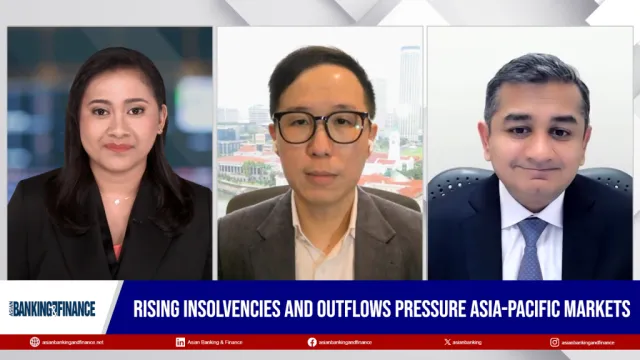
Strengthening ability to withstand uncertainties ‘crucial’ for financial stability, says Deloitte Singapore Audit & Assurance Chief Strategy & Operations Officer
Ho Kok Yong said the financial services sector should stay vigilant about inflation, turbulence in capital markets, and the implication of ‘policy normalisation.’
Deloitte Singapore Audit & Assurance Chief Strategy & Operations Officer Ho Kok Yong has more than 25 years of public accounting experience involving the financial audits and regulatory reviews of multinationals and local companies, spanning across a diverse range of industries, including entities in the banking and capital markets, as well as the investment management industry.
Being one of the judges in this year’s Asian Banking and Finance Awards, Ho was expecting the entries to focus more on humanising the banking experience and empowering customers.
For 2022, Ho believes that overall financial prospects are generally positive for the banking industry amidst the uncertainties surrounding the COVID-19 pandemic.
How would you assess the overall performance of Asia’s banks and financial institutions for the past year? What are some of the key aspects that are worth recognising?
In the past year, banks and financial institutions (FIs) in Asia were impacted by the tectonic shifts that reconfigured the global financial system. These shifts include phenomenal growth in digitisation, convergence of industries, fusion of technologies, proliferation of an increasingly intertwined ecosystem, and blurring of product constructs. Notwithstanding these, perhaps the ultimate gut punch was delivered by the COVID-19 pandemic that tested banks' and FIs’ resilience in unforeseen ways. Yet, they have emerged stronger, proving that they have the ability to overcome the challenges that come their way.
As more economies recover from the impacts of the COVID-19 pandemic, what are some of the opportunities that businesses can explore?
As we move forward in 2022 towards 2023, the defining features of the global macroeconomic environment are marked by regional differences in economic performance and significant fragility in the outlook. Following a global contraction in 2020, much of the global economy returned to growth in 2021 and is forecast to continue to grow (albeit somewhat slower) in 2022 and into 2023. However, global aggregate figures mask significant variation between countries, and the global economy faces what the International Monetary Fund (IMF) has called a “dangerous divergence in economic prospects” between countries.
Inflationary pressures have, in some parts of the world, proved more persistent than central banks had previously anticipated. Central banks still generally envisage inflation returning to lower levels this year, though potentially remaining above targets, and it is increasingly clear that monetary policy will tighten earlier than previously anticipated through a combination of cuts in asset purchases and rises in interest rates. Meanwhile, some fiscal tightening has already begun but looks set to proceed at different speeds across countries.
In general, there remains a high degree of uncertainty around current economic projections, and even the tentatively positive economic outlooks are predicated on assumptions that lockdowns and supply chain disruptions continue to ease. The very nature of these supply chain shocks indicates the fragility of the economic recovery; the highly intertwined global economy means that the emergence of problems anywhere could potentially threaten recovery everywhere.
Notwithstanding the above, there are still opportunities. The brighter outlook for loan loss provisions is helping drive profitability for banks. But sluggish loan growth and modest interest income are likely to also dampen growth. Despite an uptick in interest rates in 2022, low rates in the short term should keep interest income/net interest margins suppressed. However, the rebound in non-interest income from higher trading revenues and growth in fee-based businesses could be more pronounced and lead to overall top-line growth. A greater focus on cost management may also help efficiency ratios improve.
Whilst uncertainty around the COVID-19 pandemic continues, overall financial prospects are generally positive for the banking industry this year.
As more banks and financial institutions are urged to employ ESG programmes in their processes, what do you think they should do to keep up with the times? What do you think will be some of the challenges in this undertaking?
Banks and FIs have the ability to alter the trajectory of climate change by taking the lead in climate finance innovation, something sorely needed to help transition companies, industries, and countries to a net-zero world. However, many of them have yet to turn their ESG commitments into concrete action.
Banks and FIs will look to regulators to set the standard. Regulators in the Asia Pacific region continue to adopt TCFD (Task Force on Climate-related Financial Disclosures) recommendations in 2022 and beyond. Developments in sustainability accounting standards and taxonomies will progress this year into the next. However, challenges remain for banks and FIs: firstly, fragmentation in taxonomies and reporting standards creates complexity for compliance; secondly, the legal framework to support the sustainability agenda continues to lag behind regulatory developments. Whilst most banks and FIs have vowed to direct capital flows to green projects and reduce their portfolio exposure to carbon emissions, many are facing mounting legal, regulatory, and ethical pressure to wind down fossil fuel financing on a quicker timeline. Regardless, banks and FIs should continue to participate in industry bodies that refine climate risk accounting and reporting standards. This will help to develop consistent standards, allowing for immediate tangible impact.
Large banks and FIs should also establish tangible criteria to achieve their emission reduction goals. They are also expected to solidify their stress testing and credit risk modelling procedures, amplify efforts to help clients manage physical and transition risks, and enhance their disclosures on climate-related risks and opportunities.
Banks and FIs should also prioritise the embedding of climate risk into their operations and the creation of new performance metrics to measure progress. In addition, they should play the leading role in continuing to innovate on climate finance through products such as target-linked bonds.
They can also invest in climate-tech startups and help developing economies that may not have easy options to switch to renewable energy.
How will banks and financial institutions deal with the unpredictable government regulations brought by the pandemic?
The Asia Pacific region continues to navigate its way to economic recovery, despite uncertainties around the ongoing COVID-19 pandemic and the scheduled roll-back of COVID-19 response measures. Although projected growth in some countries and jurisdictions across the region are leading the rest of the world, overall recovery in the Asia Pacific has been uneven as a result of new COVID-19 variants, and their impact on case numbers and hospitalisations.
2022 is the year when financial regulators, as well as central banks, aim to gradually move ’back to normal’, adjusting macroeconomic policies to combat inflation whilst supporting economic recovery. Against this backdrop, strengthening banks' and FIs’ ability to withstand uncertainties seems crucial to maintaining financial stability. Whilst digital innovation and sustainability become increasingly important topics, continued implementation of the FSB post-crisis reforms remains a top priority for Asia Pacific regulators.
As 2022 progresses, the financial services sector should stay vigilant about: the continued impact of inflation, implications of ‘policy normalisation’, and potential turbulence in the capital markets due to monetary policy tightening.
What projects are your clients currently working on as companies continue to recover from the COVID-19 pandemic?
We’ve seen many banks and FIs continuing in their digital transformation journey. However, even though digital transformation is going ahead at full speed, these efforts tend to be incremental, localised and fragmented, resulting in a pervasive and pernicious “technology trap,” which is preventing some from realising the full potential of their investments.
Powerful undercurrents from the COVID-19 pandemic are also forcing financial services industry leaders to reckon with the never-before-seen challenge of redefining the workplace and how work is done. We’ve seen banks and FIs pivoting towards a hybrid work model in today’s post-pandemic world. They have embarked on projects to make this transition—balancing worker needs with client and market demands. Specifically, we’ve seen some banks and FIs looking at reassessing rewards, including compensation, in light of this new hybrid work model. We’ve also seen an increase in banks and FIs engaging in programmes to train leaders on how best to manage a distributed workforce so that existing inequities are eliminated and new inequities do not emerge.
Lastly, we’ve seen an increase in M&A activity. Moderately low-interest rates, excess liquidity, and competition from fintechs, digital-only banks, and bigtechs are pressuring profitability and creating a sense of urgency among sellers. On the other side of the coin, attractive stock multiples and healthy capital levels are fueling buyers’ appetites.
As a judge in the Asian Banking and Finance Awards, what projects or innovations are you expecting to find amongst the entries?
The entries submitted were varied and interesting.
However, I was expecting the entries to focus more on humanising the banking experience and empowering customers. Digital interactions, whilst easy and convenient, fail to forge emotional connections. Younger generations, who tend to use digital channels the most, are also typically less brand loyal. I also hoped to see banks and FIs giving customers more access to data, financial tools and advice, and embedding finance options that are personalised and actionable. The entries should also consider aggregating products and services to meet customers’ diverse financial needs, such as tax filing, spending tracking, and buying insurance on a one-stop platform. I do see this in some of the entries, but more could be done.
The entries should also consider deploying AI (Artificial Intelligence) at scale, which for many banks can only happen in the cloud. Furthermore, no AI model can be powerful without having a robust data infrastructure in place. I did not see many of the entries focusing on their cloud strategy and data infrastructure.
Whilst some of the entries touched on regulatory compliance, I believe there is more to be done with regard to designing a modern toolbox for risk and compliance. For businesses to be truly empowered to own and manage risk, there needs to be more robust and real-time data and advanced analytical tools to flag unusual or suspicious patterns. The product-driven model of risk management should also incorporate risk scoring and assumption testing across product design, customer prospecting, origination, marketing, servicing, and termination.


















 Advertise
Advertise








